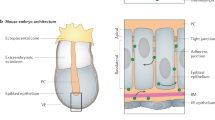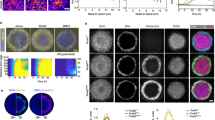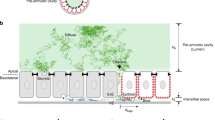Abstract
Patterning events in development often depend on the transmission over a range of several cell diameters of signals emanating from a localized source. Experimental studies of such long-range signalling by members of the TGF-β family of growth factors suggests that a cell-relay mechanism in which cells signal only with their immediate neighbours (i.e., juxtacrine signalling) may be operating in some tissues. Here, this possibility is investigated through the analysis of a model of juxtacrine signalling. Depending on the strength of the signal relay between cells, a localized signal source can generate either stable gradients or travelling fronts of cell activation. Both of these behaviors could in principle be involved in the long-range transmission of signals and patterning of cell fates by cell relays. There are significant and surprising differences between the gradients generated by the mechanism studied here, and those generated by the diffusion of a morphogen. In particular, there is an upper limit on the distance over which any given level of cell activation can be attained in a relay-mediated gradient, irrespective of the strength of signal source.
Similar content being viewed by others
References
Babloyantz, A. (1977). Self-organization phenomena resulting from cell-cell contact. J. Theor. Biol. 68, 551–561.
Collier, J. R., N. A. M. Monk, P. K. Maini and J. H. Lewis (1996). Pattern formation by lateral inhibition with feedback: a mathematical model of Delta-Notch intercellular signaling. J. Theor. Biol. 183, 429–446.
Crick, F. H. C. (1970). Diffusion in embryogenesis. Nature 225, 420–422.
Fagotto, F. and B. Gumbiner (1996). Cell contact-dependent signaling. Dev. Biol. 180, 445–454.
Green, J. B. A., H. V. New and J. C. Smith (1992). Responses of embryonic Xenopus cells to activin and FGF are separated by multiple dose thresholds and correspond to distinct axes of the mesoderm. Cell 71, 731–739.
Green, J. B. A. and J. C. Smith (1990). Graded changes in dose of a Xenopus activin A homologue elicit stepwise transitions in embryonic cell fate. Nature 347, 391–394.
Grell, M., E. Douni, H. Wajant, M. Lohden, M. Clauss, W. Maxeiner, S. Georgopoulos, W. Lesslauer, G. Kollias, K. Pfizenmaier and P. Scheurich (1995). The transmembrane form of tumor necrosis factor is the prime activating ligand of the 80 kDa tumor necrosis factor receptor. Cell 83, 793–802.
Gurdon, J. B., P. Harger, A. Mitchell and P. Lemaire (1994). Activin signaling and response to a morphogen gradient. Nature 371, 487–492.
Gurdon, J. B., A. Mitchell and D. Mahony (1995). Direct and continuous assessment by cells of their position in a morphogen gradient. Nature 376, 520–521.
Gurdon, J. B., A. Mitchell and K. Ryan (1996). An experimental system for analyzing response to a morphogen gradient. Proc. Natl. Acad. Sci. USA 93, 9334–9338.
Jones, C. M., N. Armes and J. C. Smith (1996). Signaling by TGF-β family members: short-range effects of Xnr-2 and BMP-4 contrast with the long-range effects of activin. Curr. Biol. 6, 1468–1475.
Krasnow, R. E. and P. N. Adler (1994). A single frizzled protein has a dual function in tissue polarity. Development 120, 1883–1893.
Krasnow, R. E., L. L. Wong and P. N. Adler (1995). Dishevelled is a component of the frizzled signaling pathway in Drosophila. Development 121, 4095–4102.
Lecuit, T., W. J. Brook, M. Ng, M. Calleja, H. Sun and S. Cohen (1996). Two distinct mechanisms for long-range patterning by Decapentaplegic in the Drosophila wing. Nature 381, 387–393.
Massagué, J. (1996). TGF-β signaling: receptors, transducers, and Mad proteins. Cell 85, 947–950.
McMahon, D. (1973). A cell-contact model for cellular position determination in development. Proc. Natl. Acad. Sci. USA 70, 2396–2400.
Murray, J. D. (1993). Mathematical Biology, 2nd edn, Berlin: Springer-Verlag.
Nellen, D., R. Burke, G. Struhl and K. Basler (1996). Direct and long-range action of a dpp morphogen gradient. Cell 85, 357–368.
Nieuwkoop, P. D. and B. Albers (1990). The role of competence in the craniocaudal segregation of the central nervous system. Dev. Growth Differ. 32, 23–31.
Othmer, H. G. and L. E. Scriven (1971). Instability and dynamic pattern in cellular networks. J. Theor. Biol. 32, 507–537.
Reilly, K. M. and D. A. Melton (1996a). The role of short-range and long-range signaling in mesoderm induction and patterning during Xenopus development. Sem. Cell and Dev. Biol. 7, 77–85.
Reilly, K. M. and D. A. Melton (1996b). Short-range signaling by candidate morphogens of the TGF-β family and evidence for a relay mechanism of induction. Cell 86, 743–754.
Serrano, N. and P. H. O’Farrell (1997). Limb morphogenesis: connections between patterning and growth. Curr. Biol. 7, R186–R195.
Smith, J. C. (1995). Mesoderm-inducing factors and mesodermal patterning. Curr. Opin. Cell Biol. 7, 856–861.
Wall, N. A. and B. L. M. Hogan (1994). TGFβ-related genes in development. Curr. Opin. Genet. Dev. 4, 517–522.
Wolpert, L. (1969). Positional information and the spatial pattern of cellular differentiation. J. Theor. Biol. 25, 1–47.
Author information
Authors and Affiliations
Rights and permissions
About this article
Cite this article
Monk, N.A.M. Restricted-range gradients and travelling fronts in a model of juxtacrine cell relay. Bull. Math. Biol. 60, 901–918 (1998). https://doi.org/10.1006/bulm.1998.0046
Received:
Accepted:
Issue Date:
DOI: https://doi.org/10.1006/bulm.1998.0046




